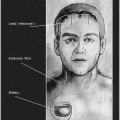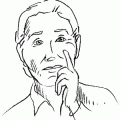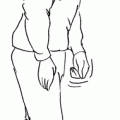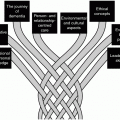and Kelvin L. Chou2
(1)
Parkinson’s Clinic of Eastern Toronto & Movement Disorders Centre, Toronto, ON, Canada
(2)
Michigan House, University of Michigan Medical School, Ann Arbor, MI, USA
Keywords
TremorCase studiesCase presentationsClinical pearlsCase #1
Chief Complaint
Tremor of Hands.
History
This 18 year old right handed man initially noticed tremor of his right hand 3 months ago. Recently, he has noticed a slight tremor of his left hand as well. The tremor usually occurs only when he is holding objects such as a cup of coffee and during activity. There has been no change in his handwriting. He has no problem with eating, drinking from a glass full of liquids, or carrying out other activities of daily life. He has no history of thyroid disease. There is no history of antipsychotic/antiemetic use or exposure to any toxins. He does not drink alcohol and denies using illicit drugs. Family history is notable for a father with a similar tremor, though more severe. He has no other medical problems.
Examination
He had mild amplitude, 9 Hz, flexion-extension tremors of both hands when outstretched, in wing beating position and on finger-nose-finger testing without any intention component. There was no resting tremor of the hands, bradykinesia or rigidity. There was no tremor of his voice, head, lips, chin, jaw, or lower extremities. The rest of the neurological examination, including tandem gait, was normal. His handwriting did not show any tremor. Spiral drawing showed a minimal tremor.
Diagnosis
Essential Tremor.
Case Discussion/Clinical Pearls
This patient presented with a 3 month history of bilateral action tremor of the hands, but no other complaints. While we do not know whether the tremors are responsive to alcohol, the presence of bilateral action tremors of the hands with a positive family history is highly suggestive of essential tremor.
While family history and alcohol responsiveness are supportive features of essential tremor, they do not have to be present to make the diagnosis. Enhanced physiologic tremor is in the differential diagnosis, but typically has a higher frequency. Nevertheless, thyroid studies should be done to rule out thyrotoxicosis. Because the patient is young, serum ceruloplasmin, 24 h urinary, and slit lamp examination for Kayser-Fleischer rings to rule out Wilson’s disease may also be considered, though in this case, the presentation is fairly typical for essential tremor and it would be reasonable to defer testing until features that are atypical for essential tremor appear. The tremor is not interfering with activities of daily life at this point, so we would favour reassuring the patient that he does not have a neurodegenerative disorder such as Parkinson disease and monitor the condition. Treatment can be discussed when the tremors begin to interfere with activities.
Case #2
Chief Complaint
Tremor of both hands.
History
This is a 75 year old right handed man who noticed the gradual onset of bilateral hand tremor approximately 5 years ago. The tremors have worsened over that time, but particularly over the last 6 months. The tremor occurs when he is using his hands to perform activities, but he has also noticed them when his hands are in a resting position. His handwriting has become very coarse and tremulous over the last year. He finds difficulty drinking fluids, pouring, and using a spoon and fork while eating. He has stopped eating in public because of embarrassment. Others have mentioned that his head shakes, but he has not noticed it. Voice is normal. He is slightly slow in walking, a result that he attributes to arthritis; he may occasionally drool at night time while sleeping. His balance is not as great as it was before, and he may feel unsteady on his feet when he turns quickly. However, this has not resulted in any falls. He does not drink alcohol and there is no family history of tremor or Parkinson disease. He has no history of thyroid disease. There is no history of antipsychotic/antiemetic use or exposure to any toxins. Past medical history is significant only for hypertension, for which he takes an ACE inhibitor. He has no other medical problems and takes no other medications.
Examination
He had moderate amplitude, 8 Hz, flexion extension tremor of both hands when outstretched, in wing beating position and on finger-nose-finger testing without any intention component. There was mild amplitude, 8 Hz, flexion extension tremor of both hands with the hands resting in the lap, which disappeared on complete repose in supine position. There was a fine, high frequency, head shaking tremor, not worsened with different head positions. There was no tremor of head, voice, lips, chin, jaw or lower extremities. He had mild cogwheeling of both upper extremities at the elbows. There was no bradykinesia. His speed of walking was slightly slow, his gait was of an antalgic pattern. The rest of the neurological examination including tandem gait was normal. His handwriting and spiral drawing showed a moderate kinetic tremor.
Diagnosis
Essential tremor, interfering with activities of daily life.
Case Discussion/Clinical Pearls
This patient presents with bilateral tremor of the hands, present in a “rest” position, but worse with action, as well as a fine head tremor. Though his age and the presence of a rest tremor may bring up the possibility of Parkinson disease, this patient’s tremor is worse with action, and when special attempts are made to completely relax the hands, the tremor disappears. The presence of a head tremor and a 5 year history without any evidence of bradykinesia on exam are other features of this case that are inconsistent with a diagnosis of Parkinson disease, making essential tremor the most likely diagnosis.
Thyroid studies would be reasonable tests to order if not done so already. No imaging tests are necessary. Because the tremors interfere with activities of daily living, the clinician should discuss treatment options with the patient. Both propranolol and primidone are acceptable first-line agents in this case. For propranolol, we recommend a starting dose of 20 mg three times daily or 60 mg daily in an extended release formulation. For primidone, we recommend starting with half of a 50 mg tablet at bedtime and titrating up on a weekly basis for effect.
Case #3
Chief Complaint
Tremor of both hands.
History
This 28 year old right handed Asian woman initially noticed tremor of both of her hands about 3 months ago. The tremor occurs mainly when holding objects and when using the hands. There is no tremor with the hands in a resting position. There is no significant change in handwriting. While there is tremor with drinking from a glass, eating, and putting on makeup, it is not so severe that she cannot perform them. She does not drink alcohol. Over the same time, she has noticed poor heat tolerance, increased perspiration, diarrhoea, occasional heart palpitations, and mild weight loss. There is no history of antipsychotic/antiemetic use or exposure to any toxins. She has no other medical problems. She is currently taking only a birth control pill.
Examination
She had a mild amplitude, 12 Hz, flexion extension tremor of both hands when outstretched. There was no tremor in the wing beating position or on the finger-nose-finger testing. Handwriting and spiral drawing did not reveal any tremor. There was no resting tremor in the hands and no tremor of voice, head, lips, chin, jaw, or lower extremities. The rest of the neurological examination, including tandem gait, was normal. Of note, her resting heart rate was 98.
Case Discussion/Clinical Pearls
This is a young woman with a mild action tremor of both hands. The main diagnostic considerations include enhanced physiologic tremor or essential tremor. Drug-induced tremor would also be a consideration if she was on a medication that could cause tremors. With her other constitutional symptoms, such as heat intolerance, palpitations and weight loss, thyroid studies were ordered. Her serum TSH was much below the normal range with an increase in the free T4 level. Thus, a diagnosis of tremor due to hyperthyroidism was made. She was referred for endocrinology consultation, and her tremors resolved once hyperthyroidism was under control.
Case #4
Chief Complaint
Head tremor.
History
This is a 47 year old right handed woman who initially noticed a head tremor 9 months ago. She reports that her head shakes side to side and tends to turn towards the left side. This is accompanied by soreness on the left side of her neck. By touching the side of her face she can bring her head back to a neutral position ceasing the tremor. However, as soon as she removes her hand, the head turns to the left and shakes again. The tremor is interfering with her social and household activities. There is no tremor involving her hands, voice, lips, jaw, chin or legs. She denies any change in her handwriting. She does not drink alcohol and there is no family history of tremor or other movement disorders. There is no history of antipsychotic/antiemetic use or exposure to any toxins. She has no known history of thyroid disease. Past medical history is significant for hypertension only for which she takes atenolol, a beta-blocker.
Stay updated, free articles. Join our Telegram channel

Full access? Get Clinical Tree







